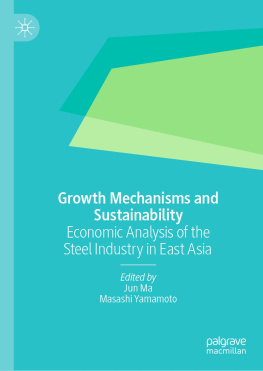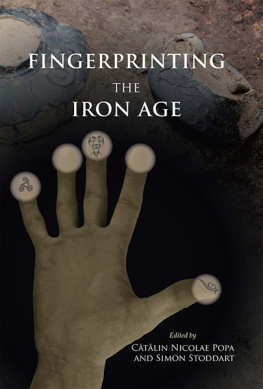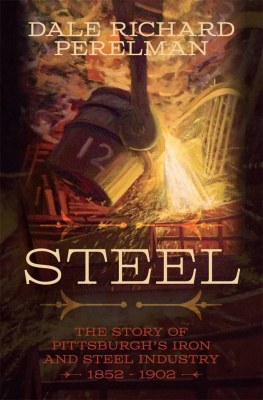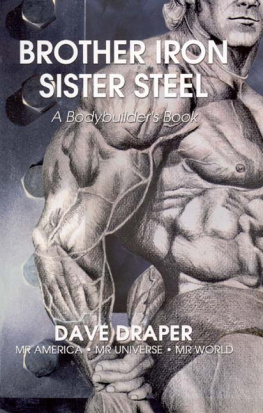ROUTLEDGE LIBRARY EDITIONS: ECONOMIC GEOGRAPHY
Volume 8
THE GEOGRAPHY OF IRON AND STEEL
THE GEOGRAPHY OF IRON AND STEEL
NORMAN J. G. POUNDS
First published in 1959
Second revised edition 1963
Third revised edition 1966
Fourth revised edition 1968
This edition first published in 2015
by Routledge
2 Park Square, Milton Park, Abingdon, Oxon, OX14 4RN
and by Routledge
711 Third Avenue, New York, NY 10017
Routledge is an imprint of the Taylor & Francis Group, an informa business
1959, 1963 and 1966 Norman J. G. Pounds
All rights reserved. No part of this book may be reprinted or reproduced or utilised in any form or by any electronic, mechanical, or other means, now known or hereafter invented, including photocopying and recording, or in any information storage or retrieval system, without permission in writing from the publishers.
Trademark notice: Product or corporate names may be trademarks or registered trademarks, and are used only for identification and explanation without intent to infringe.
British Library Cataloguing in Publication Data
A catalogue record for this book is available from the British Library
ISBN: 978-1-138-85764-3 (Set)
eISBN: 978-1-315-71580-3 (Set)
ISBN: 978-1-138-86051-3 (Volume 8)
eISBN: 978-1-315-71642-8 (Volume 8)
Publishers Note
The publisher has gone to great lengths to ensure the quality of this reprint but points out that some imperfections in the original copies may be apparent.
Disclaimer
The publisher has made every effort to trace copyright holders and would welcome correspondence from those they have been unable to trace.
THE GEOGRAPHY OF IRON AND STEEL
Norman J. G. Pounds
HUTCHINSON & CO (Publishers) LTD
178202 Great Portland Street, London W1
London Melbourne Sydney
Auckland Bombay Toronto
Johannesburg New York
First published 1959
Second (revised) edition 1963
Third (revised) edition 1966
Fourth (revised) edition 1968
The paperback edition of this book is sold subject to the condition that it shall not, by way of trade or otherwise, be lent, resold, hired out or otherwise circulated without the publishers prior consent in any form of binding or cover other than that in which it is published and without a similar condition including this condition being imposed on the subsequent purchaser
Norman J. G. Pounds 1959, 1963 and 1966
This book has been set in Times, printed in Great Britain on Smooth Wove paper by Anchor Press, and bound by Wm. Brendon, both of Tiptree, Essex
09 051001 1 (cased)
09 051002 X (paper)
CONTENTS
MAPS AND DIAGRAMS
To the list of those who in many ways have helped him in preparing the second edition of this book, the author wishes to add Professor Robert N. Taaffe who has read critically the material on the Soviet Union and made many more suggestions than could, for reasons of space, be included.
N. J. G. P.
Indiana University
This is a very small book about a very large subject. Much has been condensed and more has had to be omitted. From among many possible lines of approach, the author has deliberately chosen the historical, seeing in the present pattern of industry a kind of palimpsest, made up of the sequent patterns drawn over a period of several centuries. Each of these geographical patterns springs from the needs, the scientific knowledge and the technology of its own day and age. Each has continued to exist, in some shape or form, after the forces which created it had disappeared. Hence, in this book, there is an emphasis on the history of the technology of iron and steel.
The author wishes to express his thanks to Professor Thomas R. Smith of the University of Kansas for his most critical and helpful reading of the text, and to the following who at some stage read the manuscript, in part or in whole, and made suggestions and corrections:
Professor S. Earl Brown of Ohio State University, Professor W. Gordon East, Mr Leonard B. Tennyson and his colleagues of the European Coal and Steel Community, Mr James K. Welsh and Mrs Joan Wilson Miller; also to Mr D. R. Baker who drew the maps.
NORMAN J. G. POUNDS
Kansas University
March, 1959

FIG. 1. Iron-ore deposits of the world with amount of probable reserves
(Based primarily on World Iron Resources and their Utilization, U.N., 1950, and Survey of World Iron Ore Resources, U.N., 1955)

FIG. 2. Iron and steel works of the world
(Based on Iron and Steel Works of the World, ed. H. G. Cordero)
EARLY in the second millennium before Christ the process of smelting iron was discovered. The discovery was made in the Middle East, but by what combination of accident and intuition we do not know. Knowledge of the process spread slowly, first to Egypt and then to the Aegean, where, even in Homeric times, iron was regarded as a rare metal and weapons were made of brightly shining copper.1 The use of iron reached the basin of the Upper Danube by about 900 B.C., and from this area it was carried by the migrating Celts westwards into France and the Iberian peninsula, and north-westwards across Germany to the British Isles.
Iron-ore is one of the most widely distributed of the metallic minerals. Primitive man must on countless occasions have built his hearth of lumps of iron-bearing rock, and sooner or later he was bound unwittingly to achieve the conditions under which the ore could be reduced to an impure metal. The ore consists of metallic iron in chemical combination with varying quantities of oxygen, carbon and sulphur. Other substances, especially phosphorus and manganese, may also be present in the ore and influence, adversely or otherwise, the quality of the metal that may be obtained from it.
Some constituents of the ore can be driven off by the simple process of heating, but the removal of others can be achieved only by their chemical combination with oxygen or carbon. Yet others have defied the skill and ingenuity of the iron-worker, and continue to plague the modern metallurgist.
Pure iron melts at the temperature of 1537C, but long before this temperature is reached the metal becomes a pasty mass that can be kneaded and shaped by means of a metal rod. Molten iron is capable of dissolving carbon, which in turn has the effect of lowering the melting point of the iron. Indeed, the melting point of the iron can be brought down to 1130 if it can be made to dissolve sufficient carbon.
Such temperatures as these were unlikely to be achieved by primitive man. In fact, it is improbable that a really fluid iron was regularly created before the invention of the blast-furnace in the later Middle Ages. The possibility cannot be discounted, however, that occasionally, even before this, unusually favourable circumstances may have allowed the iron to fuse completely. Indeed, the evidence, both literary and archaeological, compels one to this belief. But it remains generally true that, before the fifteenth century, iron was obtained in Europe as a pasty lump that could be shaped by hammering, not as a liquid that could be run into a mould.















